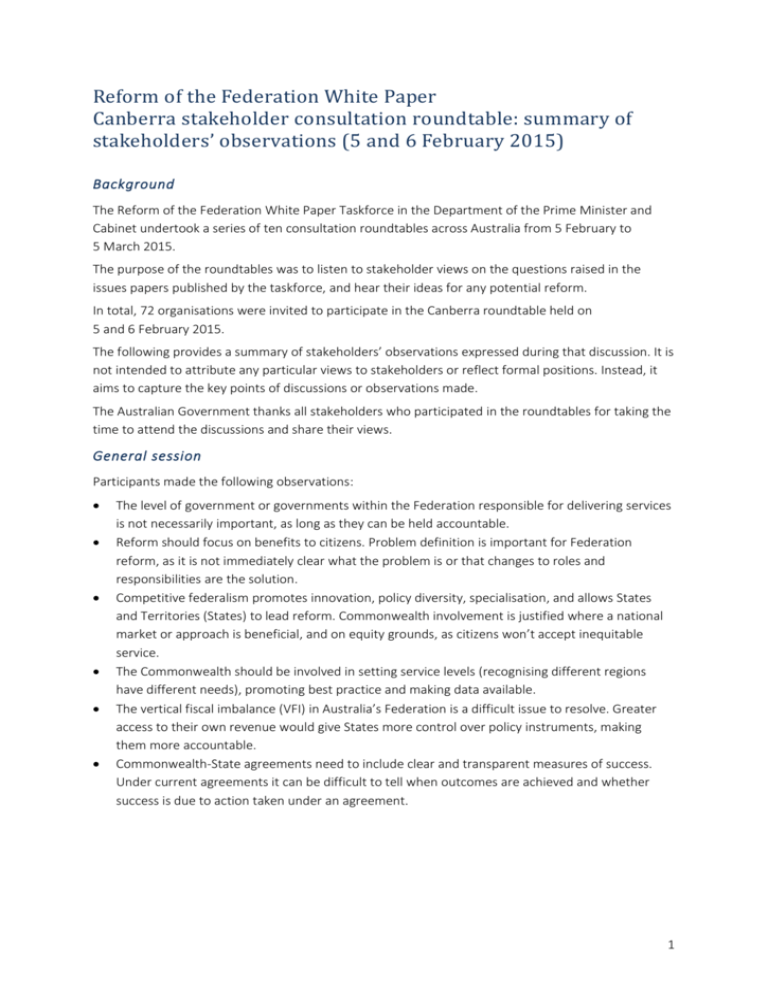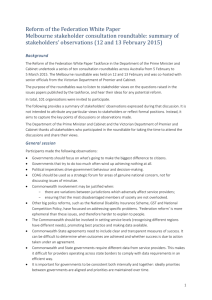Reform of the Federation - Canberra stakeholder consultation
advertisement

Reform of the Federation White Paper Canberra stakeholder consultation roundtable: summary of stakeholders’ observations (5 and 6 February 2015) Background The Reform of the Federation White Paper Taskforce in the Department of the Prime Minister and Cabinet undertook a series of ten consultation roundtables across Australia from 5 February to 5 March 2015. The purpose of the roundtables was to listen to stakeholder views on the questions raised in the issues papers published by the taskforce, and hear their ideas for any potential reform. In total, 72 organisations were invited to participate in the Canberra roundtable held on 5 and 6 February 2015. The following provides a summary of stakeholders’ observations expressed during that discussion. It is not intended to attribute any particular views to stakeholders or reflect formal positions. Instead, it aims to capture the key points of discussions or observations made. The Australian Government thanks all stakeholders who participated in the roundtables for taking the time to attend the discussions and share their views. General session Participants made the following observations: The level of government or governments within the Federation responsible for delivering services is not necessarily important, as long as they can be held accountable. Reform should focus on benefits to citizens. Problem definition is important for Federation reform, as it is not immediately clear what the problem is or that changes to roles and responsibilities are the solution. Competitive federalism promotes innovation, policy diversity, specialisation, and allows States and Territories (States) to lead reform. Commonwealth involvement is justified where a national market or approach is beneficial, and on equity grounds, as citizens won’t accept inequitable service. The Commonwealth should be involved in setting service levels (recognising different regions have different needs), promoting best practice and making data available. The vertical fiscal imbalance (VFI) in Australia’s Federation is a difficult issue to resolve. Greater access to their own revenue would give States more control over policy instruments, making them more accountable. Commonwealth-State agreements need to include clear and transparent measures of success. Under current agreements it can be difficult to tell when outcomes are achieved and whether success is due to action taken under an agreement. 1 Housing and Homelessness Participants made the following observations: It is the role of government to intervene to address market failure in affordable housing. Governments have an international obligation to provide appropriate housing. Housing is one area the social contract between a nation and its citizens is activated. To improve housing affordability, supply impediments need to be addressed; roles and responsibilities are a second-order issue. To increase the supply of affordable and appropriate housing an increase in government funding is required. Current tax settings encourage over-investment in expensive housing and under-investment in affordable housing. The Commonwealth misunderstands how current funding (provided through the National Affordable Housing Agreement (NAHA)) is used by States. A lot goes to community housing and to support people in the private market. National Rental Affordability Scheme-like programmes are needed to encourage institutional investment in affordable housing. These programmes can achieve the requisite scale and efficiency if they are national. The Commonwealth’s role should include mobilising social and institutional investment in affordable housing. Community housing providers are more likely to be willing than State governments to raise debt to finance investment in social housing. Extending Commonwealth Rent Assistance (CRA) to public housing tenants will provide a disincentive for States to divest supply to community housing. This reform will increase Commonwealth financial liability over time, as NAHA is decreasing while CRA is increasing. It will not increase the supply of affordable housing. Need to find a way to free up stock that allows people to retain eligibility for Age Pension and other entitlements. The Commonwealth should play a role in gathering and disseminating information, ensuring equality, and imposing transparency around standards and performance indicators. The Commonwealth is effective as an intermediary and States are efficient at tailoring design to local conditions. The National Housing Supply Council was a worthwhile independent body disseminating valuable information to governments. The COAG Select Council on Housing and Homelessness was also a valuable forum (now abolished). Health Participants made the following observations: The public holds all governments responsible for health care. It isn’t important who is responsible, as long as services are available. Reform should take a ‘bottom up’ approach, focussing on people with chronic / complex conditions that the current arrangements are not working for and who are the highest cost users of the system. Better support could include more coordinated health care. Funding and delivery arrangements should be flexible enough to allow services to cater for the specific circumstances of individual communities, particularly in non-urban areas. Funding models 2 should allow some resources to be allocated to meet local needs, and be pooled across sectors so care does not break down at ‘transition points’ between services. Reform should harness existing cooperation between providers (as occurs through primary health networks) and take advantage of the diverse mix of service providers involved in health care, particularly exploring public-private partnerships and taking a broader approach to primary care. Reform also needs to be mindful of market forces operating in the health sector. For instance, the Commonwealth underwrites the GP market (through the MBS), but the location of services is driven largely by commercial incentives. Agreed national targets / services levels / standards are desirable and need to: be flexible enough to take regional differences into account; provide incentives for efficient health care across the system (not each part of the system in isolation); and not impose unnecessary reporting burdens but hold governments to account. Activity-based funding is a good model, but needs to better distinguish regional differences. In assessing the overall success or failure of programmes it is important to understand what did / didn’t work well on a local level. This way successful components can inform other programmes. Improved access to and use of data would help improve services, and allow the health care workforce to be used in a more efficient and integrated way. The sector is ‘reform weary’ and wary that each change in government, State or Commonwealth, affects the continuity of programmes. Early Childhood and Schools Participants made the following observations: Local government and the schooling sector have the capacity to play a greater role in the delivery of child care and early learning services. This is currently prevented by regulatory barriers. Teacher quality is essential to delivering better educational outcomes, but implementation of teacher quality initiatives can be fragmented. Durability of reform is important: rapid policy shifts resulting from changing governments are difficult to manage. Funding uncertainty and reporting conditions on service providers can have adverse consequences for outcomes. The development of national standards does not necessarily require Commonwealth involvement. However, it has a role to play in getting the states ‘to the table’. The Commonwealth’s involvement in the development of recent national approaches has been important. Many are in their infancy and require ongoing Commonwealth involvement. The subsidiarity principle stops at the school gate rather than with State governments. Principals should be accountable to their school communities. In early childhood, government policies need to foster and encourage quality early learning and pursue equitable outcomes. In schooling, the focus should be on improving, rather than redesigning the system. States should be responsible for delivery. The private sector could administer light touch national standards on behalf of all levels of government. A ‘one-stop-shop’ for both Commonwealth and State regulation could be pursued. A ‘needs based’ funding model is sound and could deliver more equitable outcomes and a sector blind approach will increase accountability. The Commonwealth should continue its direct relationship with non-government schools. 3 The Commonwealth should be involved in the provision of services to children with a disability. Vocational Education and Training (VET) and Higher Education Participants made the following observations: VET is often seen as the “poor cousin” of the education system and its policy objectives keep changing as it moves in and out of different portfolios. It can be argued there are roles for both the Commonwealth and the States in VET. VET is a key part of Australia’s economy (both nationally and internationally) and there is a direct relationship between the VET sector and employment and economic policy, giving the Commonwealth a role in meeting national needs and / or skills of genuine national significance. The States ensure local needs are met. On the other hand, higher education shows that a system managed by the Commonwealth can still meet local training needs. The differences between the States are confusing for industry and make the system unnavigable, particularly in apprenticeships and VET in schools (VETiS) (school based apprenticeships). This discourages businesses from participating in the VET system. Anything that goes across boundaries should therefore be a federal responsibility. Industry could play a greater role in funding and regulation of VET. There is an incongruity in the VET FEE-HELP scheme where the States sets the fees and public subsidy rules, and the Commonwealth sets the rules and provides the loan scheme (whereas in higher education, the Commonwealth sets the rules around subsidy levels and manages loans). This makes it difficult for the Commonwealth to provide funding to the States for VET without conditions and the Commonwealth needs to think about how far it extends its loan scheme. In higher education, changes in reporting arrangements wouldn’t make any difference in practical terms for student outcomes, but would require an enormous amount of work for no real difference in outcomes (just an exercise in rearranging the deck chairs). The States shouldn’t be making decisions about establishment of universities; it should be sufficient that the Tertiary Education Quality and Standards Agency (TEQSA) approve new universities. On the other hand, universities are important to local economies so some preferred to leave the current arrangements in place. The higher education reforms currently being considered by the Australian Parliament may result in more diplomas and advanced diplomas moving from VET to higher education. Some argued that there needs to be funding neutrality to retain these differences and avoid perverse outcomes. 4





